THE DYNAMIC PROPERTIES OF THE ATLANTA STONE MOUNTAIN GRANITE
Stone Mountain Park Granite Rock
Built Environment Interior
The Stone Mountain rock formation is a majestic part of the horizon and dominant as a part of the environment. Stone Mountain Granite rock has a story that dates back 300 million years. The rock mountain has attracted humans and animals alike, who seek the nature of the mountain. The mineralogy or the granite consist of quartz, alkali feldspar. Plagioclase feldspar, and biotite and muscovite mica.
Sheets of granite parallel to the surface of the mountain appear to flake off. The process occurs as the rock is shaved off over millions of years. The surface removal of stone releases pressure on the hardening granite.
The huge exposed granite rock originated from a pluton beneath the earth surface in the mantle. The stress from movement of the surrounding materials and weight of above rock structure causes the pluton pressure to increase. The pressure forces magma to push outward and buoyancy cause it to penetrate the upper crust and intruded above the surface to form this igneous granite rock. Rapid cooling formed the outer crust and slower cooling crystallized the core and solidified the minerals. Pluton: intrusive igneous rock that crystallized from magma. Cooling slowly beneath the earth surface. Plutons include dykes, batholiths, stocks, laccoliths, otoliths and other igneous bodies.
Pluton Intrusion Diagram
Stone Mountain rises approximately 750 ft. Above the surrounding countryside. The volume one-half billion cubic feet (Watson, 1902) and the area are over 583 acres. Only the tip of the granite body is above ground. The intrusion began at a depth of 10 mi. Below the surface more than 15 million years ago. Weathering occurred and slowly exposed the layers of overlying rock.
Alligator Back Formation
It can be found in the valley of Stone Mountain State Park. Also, the formation is present as xenoliths.
The picture is a xenolith located on the dome’s north side of the trail.
Exfoliation Slabs
Exfoliation slabs are visible, show layers of rocks on the face of the mountain. This process is when pressure forces a fragment to flake off. The fragment shaves the surface and reduces pressure and allows expansion.
Pegmatite Intrusion
Pegmatite – The Stone Mountain Granite cooled faster on the outside than on the inside, and the new magma found its way into fractures in the cooling granite. The mineralized fractures are called dikes classified according to the type of rock that has filled the fracture and the mineral grain size.
Weathering Pits
Weathering Pits – round holes and depressions in the granite, water plus organic acids dissolve the rock. Weathering changes physical or chemical rock properties. Fragmented rock, ice, rain. Minerals react and change the composition
Xenoliths Exposed
Xenoliths – exposed, fragments of rock engulfed by the pluton when it was still magma. The rock enclosed is of a different type and is older than the granite. The Maltin rock was forced into magma through cracks and dykes in the granite. Xenoliths represent a geological event in time.
Joints and Cracks
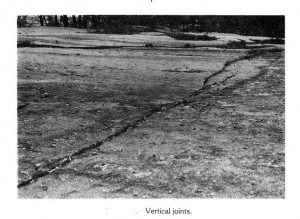
Joints are cracks that formed as the granite cooled,
cause tension during contraction cooling process
Faults and Tension / Compression Dykes
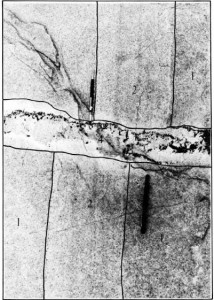
Faults cracks from fracture generated by tension or compression
Dykes contain pegmatite and aplite in the walls filled during contraction cracking. The most distinguishing characteristic of pegmatite is its large crystals of easily recognizable minerals: quartz, feldspar, mica, and tourmaline.
Old Rock Quarry
The old rock quarry is accessible from the trail. Si structures are visible, blocks of granite removed for built environment applications.
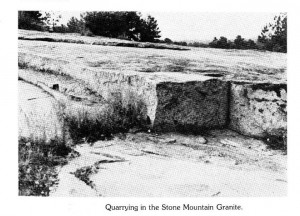
Quarrying minerals such as biotite, tourmaline, quartz, and feldspar
Diabase – dark colored rock fine grain, rich in iron and magnesium that cross-cuts the granite. Releases iron due to weathering, an orange color is in the soil from leaching.
A subvolcanic rock, also known as a hypabyssal rock, is an intrusive igneous rock that is emplaced at shallow depths within the crust and has intermediate grain size and often porphyritic texture between that of volcanic and plutonic rocks. Subvolcanic rocks include diabase (also known as dolerite) and porphyry. Typical examples of subvolcanic rocks are diabase, quartz-dolerite, micro-granite and diorite.
Trail Map Geologic Evidence
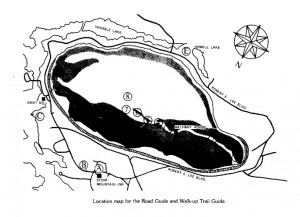
Visiting the Geologic Trail
Rock sample pictures gathered for identification
Specimen left – biotite, quartz, and feldspar
Specimen right – Feldspar and quartz
Specimen top – Pyrite, biotite, quartz, and feldspar
Specimen group – contain biotite, tourmaline, quartz, and feldspar
Picture of a pluton
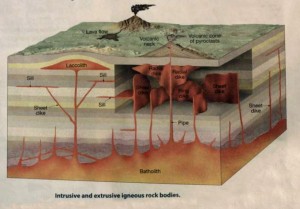
Historic Rock Table Stone Mountain
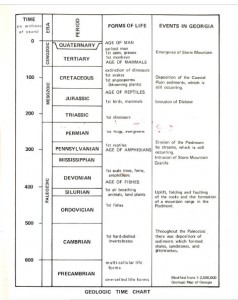
Geologic time chart for Stone Mountain Georgia. The timeline shows the era, geologic period, and the corresponding habitation for that period. The last column describes the events that occurred during the geologic period.
Built environment, The Stone Mountain rock formation is a majestic part of the horizon and dominant as a part of the environment. Stone Mountain rock has a story that dates back 300 million years. The rock mountain has attracted humans and animals alike, who seek the nature of the mountain. The man has such a dominant presence in space that the character of the mountain has been disguised and barricaded. The current park theme promotes the park and some local history to draw tourist and community. The land use agreement is good it preserves the integrity of the grounds. There is a potential for mining, dumping, poaching, so the regulation and barriers are functional.
Stone Mountain Park is the site for this built environment description. The park contains the real gem, the rock mountain that towers over everything in its vicinity. The park northeast of Atlanta near 16 miles and accessible via US-78. The park was built in the 1850s as a tourist attraction.
The Confederate memorial of the generals was carved during the 1900s. Additional amusement and activities encourage tourists and travelers to visit this monumental attraction. Vendors sell Activities, refreshments, and souvenirs. The grounds are maintained by the state and city staff. Maps guide the visitors to the features of the park. The park design allows joggers and walkers, picnickers, and bike riding activities to occur on dedicated paths. The restricted travel provides safety and control of traffic flow. The park is accessible from all sides. Highway 78 provides an exit to Stone Mountain Park. The park is closed; a fee is required to access the park by car. Foot traffic is free of charge for access. The hours of operation are dusk to dawn, seven days per week.
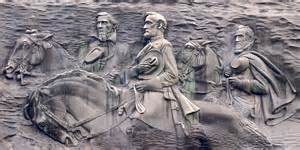
The park features a grand artifact; Carving of Confederate generals. There is an exhibit of the succession. Stations are set up for each state with a tablet containing the history of the event. The Stations are permanent as an outdoors year round exhibit. The carving is cleaned and maintained by the park attendants.
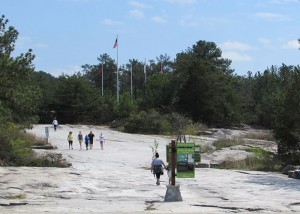
The primary users are recreation seekers. The secondary users are leisure dwellers. The largest group to visit the park are event participants. The events draw thousands of spectators. The summer events are concerts and special interest group gatherings. In the winter, the snow run is the largest draw. There is a cable car to transport people to the top of the mountain. The lift operates all season. The park is commercial in its service delivery. The park attempts to accommodate all levels of users. The space utilization is excellent; the activity areas are seamlessly divided by function and resources.
Works Cited
Atkins Robert L., Joyce Lisa G. “Geologic Guide to Stone Mountain Park”, Georgia Department of Natural Resources, Atlanta, 1980, Web. 3 Apr. 2016, http://epd.georgia.gov/sites/epd.georgia.gov/files/related_files/site_page/GG4.pdf
Busch, Richard M. “Physical Geology” American Geosciences Institute, 2015, The Web. 3 Apr. 2016
Marshak Stephen, “Essentials of Geology 4th Edition”, W. W. Norton & Company, New York, 2013, The Web. 3 Apr. 2016
Tsembelis, S.J. Kingsbury, K. and Proud, W.G. “The Dynamic Properties of the Atlanta Stone Mountain Granit, Cavendish Laboratory, Madingley Road, Cambridge, CB3 0HE. The UK, 2003
Stewart Bruce E., “Georgia Encyclopedia, Stone Mountain” the University of Georgia, 05/25/2004 Last edited by NGE Staff on 3/08/2016, The Web. 3 Apr. 2016,
http://www.georgiaencyclopedia.org/articles/geography-environment/stone-mountain
Stone Mountain Park website, http://www.stonemountainpark.com/activities Stone Mountain Park website” A interactive geologic guide”, n.d. Web. 22 Apr. 2016. Web. 3 Apr. 2016, http://www.ncgeology.com/Stone_Mountain_State_Park/pages stone_mountain_geology_rock_types_fe atures.html
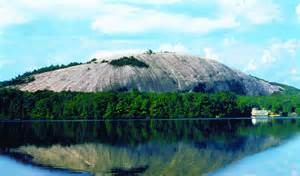
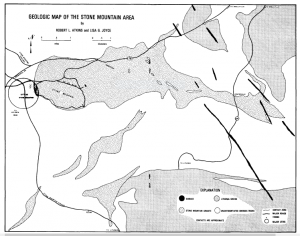
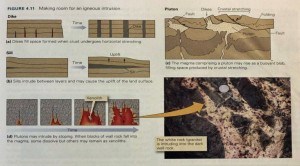
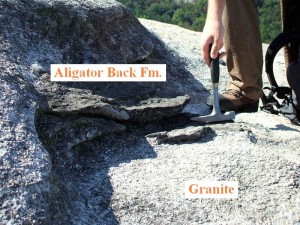

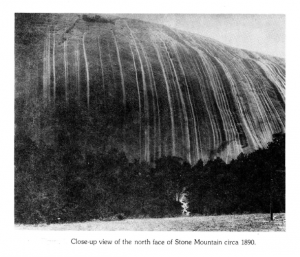
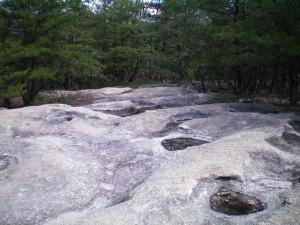
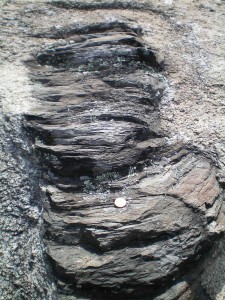
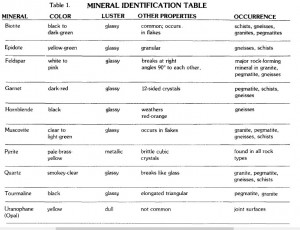

Recent Comments